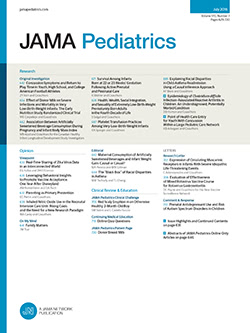鼻内咪达唑仑用于儿童手术镇静的最佳剂量
IF 18
1区 医学
Q1 PEDIATRICS
引用次数: 0
摘要
鼻内咪达唑仑(IN)常用于儿童手术镇静,但最佳剂量尚不清楚。剂量不足可能导致镇静不足,导致与处理不当的程序性疼痛和窘迫相关的短期和长期后果,而剂量过高可能与更多不良事件相关。目的探讨咪达唑仑在小儿创伤修补术中应用镇静的最佳剂量。设计、环境和参与者本前瞻性、双盲、适应性选择随机临床试验采用Levin-Robbins-Leu顺序选择程序,于2021年9月至2024年5月在三级护理儿科急诊科进行。参与者为6个月至7岁的儿童,患有单纯的撕裂伤,需要咪达唑仑来促进修复。顺序选择程序淘汰了与最佳表现剂量相比,未能达到预先规定的充分镇静状态率的剂量。如果超过1个剂量存活,则比较剩余剂量的次要结果。数据分析时间为2024年6月至8月。干预措施:0.2、0.3、0.4或0.5 mg/kg咪达唑仑。主要结局和测量:主要结局是镇静状态充足,定义为小儿镇静状态量表(PSSS)评分为2,3或4(5分),至少95%的手术;无PSSS评分0或1分;注射咪达唑仑后17分钟内开始手术;和程序完成。次要结局包括理想镇静状态(PSSS评分为2或3分,100%完成手术)、最小镇静开始时间、不良事件、恢复时间以及临床医生和护理人员满意度。结果经序贯筛选,共101例患儿,其中女38例(37.6%);中位[IQR]年龄,3[2-4]岁)。0.2和0.3 mg/kg剂量被取消,19名儿童接受0.2 mg/kg, 24名儿童接受0.3 mg/kg。0.4和0.5 mg/kg的剂量在入组结束时仍然存在,29名儿童接受0.4 mg/kg, 29名儿童接受0.5 mg/kg。其余两种剂量的次要结局无差异,任何剂量均未发生严重不良事件。结论及相关性在这项随机临床试验中,IN咪达唑仑用于裂伤修复患儿程序性镇静的最佳剂量为0.4和0.5 mg/kg。这一发现可以为IN咪达唑仑用于程序性镇静的临床实践和未来研究提供信息。临床试验注册号:NCT04586504本文章由计算机程序翻译,如有差异,请以英文原文为准。
Optimal Dose of Intranasal Midazolam for Procedural Sedation in Children
ImportanceIntranasal (IN) midazolam is commonly used for procedural sedation in children, but the optimal dose is unclear. Insufficient dosing may result in inadequate sedation, leading to short- and long-term consequences associated with poorly managed procedural pain and distress, whereas doses that are too high may be associated with more adverse events.ObjectiveTo determine the optimal dose of IN midazolam for procedural sedation in children undergoing laceration repair.Design, Setting, and ParticipantsThis prospective, double-blind, adaptive selection randomized clinical trial used the Levin-Robbins-Leu sequential selection procedure and was conducted between September 2021 and May 2024 at a tertiary care pediatric emergency department. Participants were children aged 6 months to 7 years with a simple laceration who required IN midazolam to facilitate the repair. The sequential selection procedure eliminated doses when they failed to achieve a prespecified rate of adequate sedation state compared with the best-performing dose. If more than 1 dose survived elimination, secondary outcomes of remaining doses were compared. Data were analyzed from June to August 2024.InterventionsDoses of 0.2, 0.3, 0.4 or 0.5 mg/kg of IN midazolam.Main Outcomes and MeasuresThe primary outcome was adequate sedation state, defined as Pediatric Sedation State Scale (PSSS) score of 2, 3, or 4 (of 5) for at least 95% of the procedure; no PSSS score of 0 or 1; procedure start within 17 minutes of IN midazolam administration; and procedure completion. Secondary outcomes included ideal sedation state (PSSS score of 2 or 3 for 100% of the procedure), time to onset of minimal sedation, adverse events, time to recovery, and clinician and caregiver satisfaction.ResultsFollowing the sequential selection procedure, a total of 101 children (38 [37.6%] female; median [IQR] age, 3 [2-4] years) were enrolled. The 0.2 and 0.3 mg/kg doses were eliminated, with 19 children receiving 0.2 mg/kg and 24 children receiving 0.3 mg/kg. The 0.4- and 0.5-mg/kg doses remained at enrollment completion, with 29 children receiving 0.4 mg/kg and 29 children receiving 0.5 mg/kg. There were no differences in secondary outcomes between the 2 remaining doses and no serious adverse events with any dose.Conclusions and RelevanceIn this randomized clinical trial, the optimal doses of IN midazolam for procedural sedation in children undergoing laceration repair were 0.4 and 0.5 mg/kg. This finding can inform clinical practice and future studies of IN midazolam for procedural sedation.Trial RegistrationClinicalTrials.gov Identifier: NCT04586504
求助全文
通过发布文献求助,成功后即可免费获取论文全文。
去求助
来源期刊

JAMA Pediatrics
PEDIATRICS-
CiteScore
31.60
自引率
1.90%
发文量
357
期刊介绍:
JAMA Pediatrics, the oldest continuously published pediatric journal in the US since 1911, is an international peer-reviewed publication and a part of the JAMA Network. Published weekly online and in 12 issues annually, it garners over 8.4 million article views and downloads yearly. All research articles become freely accessible online after 12 months without any author fees, and through the WHO's HINARI program, the online version is accessible to institutions in developing countries.
With a focus on advancing the health of infants, children, and adolescents, JAMA Pediatrics serves as a platform for discussing crucial issues and policies in child and adolescent health care. Leveraging the latest technology, it ensures timely access to information for its readers worldwide.
 求助内容:
求助内容: 应助结果提醒方式:
应助结果提醒方式:


